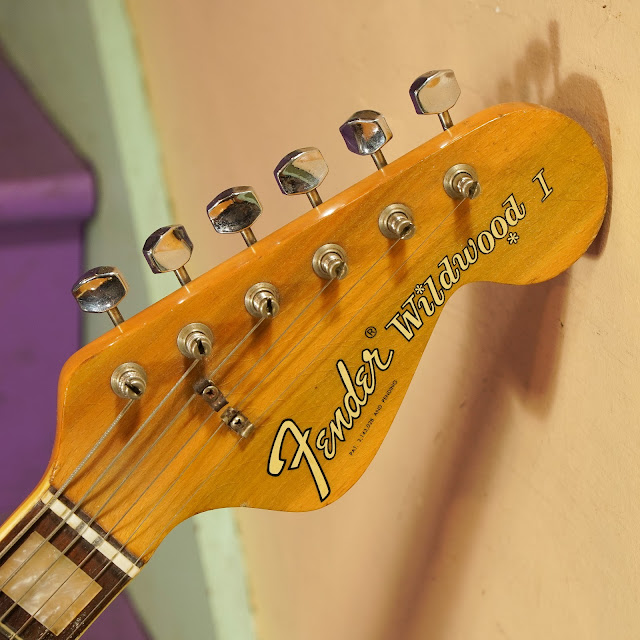1966 Fender Wildwood I (Kingman) Dreadnought Guitar
This model -- a Fender Wildwood I acoustic -- is simply a same-year Fender Kingman dreadnought but with "cool colors" for the back, sides, and headstock veneer.
The "Wildwood" colors for the back and sides were made by injecting dye into beech trees as they grew. It was then cut into veneer which, in this case, was used to face ply for the back and sides. The Wildwood I models featured "Rainbow Green" veneer which was a mix of brownish, tan, and green tones. The finish has age-yellowed a lot on this guy, though, so the subtleties of the colors have been lost for some time, though some green streaks survive here and there to add interest.
These bolt-on-neck, Fender-factory guitars get a lot of harsh criticism that I think is mostly undeserved and credited to instruments that are just in a bad state. Early versions of these designs that feature the internal (brown) metal rod connecting the endblock and neckblock are very stable instruments, however. It's a necessary design feature, too, as the neck blocks tend to "drift" (ie, loosen-up or move-around) on the later models without the rod. This "drift" is the same sort of problem found in bolted-from-the-back bolt-on neck designs offered by Epiphone and others in the '70s, too, and has to do with a small glue footprint for the neckblock around the gaping hole in the upper bout. In the case of these guitars, the metal rod takes the tendency of said design to collapse into itself out of the equation.
Suffice to say, after I repaired all the structural woes (loose bracing and top cracks, as well as fretwork), when I bolted the neck back on, adjusted the truss, and set it up at the nut... I didn't need to adjust the neck angle at all to get the action spot-on. It dialed-in to perfect height right off the bat. Compare that to the versions without the rod and I often have to stick a 1/16" shim at the neck joint to deal with all of the compression to the body that has occurred over the years.
What other features are innovative? Well, the adjustable saddles are nice to have, of course. It's easy to dial-in the intonation. A neck that has no heel is also nice to have for thumb-over chords way up the neck. The Strat-like neck is nice, too, as it plays like nothing else in the acoustic realm, really -- rock-n-roll-style sliding chord shapes are easy-peasy.
Sound-wise, though? See -- I adore these guitars. I also adore archtop guitars. I also know that most folks find these a little strange. The tone out of these is a weird mix of a good '40s Epiphone carved-top archtop tone and a '60s Gibson-ish smaller-body flattop tone. It does a sort of "LG-2" kind of woody, percussive, midsy "warmth" thing in its flattop vibe but in its "archtop" vibe it punches-forward like crazy with a ton of volume and snap -- with almost a gypsy-jazz lead bite on the treble strings.
There's a reason I have (brighter-sounding but still mellow) Pyramid flatwound strings on it... they give it a good "chuck" when chop-chording like an archtop and also help tame the crisp, lingering, steely high-end jangle that these tend to have. It helps to give the strummed chords a bit more of that "dead-wood Gibson" vibe.
Why do they sound like this? Well, that's the interesting part! It's not because of the neck joint, bolt-on neck design, steel saddles, or big internal rod like some might tell you. It's actually simpler than that. The x-bracing is mounted at very acute angles forward to rear -- the main X joint meets forward of the bridge a little below the soundhole but the arms run almost all the way to the shoulders past the soundhole. This is much tighter than any other brand of x-braced guitars I've ever handled.
Add to that the long, snappy 25 1/2" scale length and you've got a design that hypes the mids like crazy as the top -- where the tension is usually "curled" by the way the strings angle over the saddles from the pins -- is stiffer than in a Martin or Gibson design. It's also about 3/4" or more thinner at the endblock depth-wise than other dreadnoughts, giving it a response more like a 000-size guitar.
Repairs included: refret to the 12th fret, fret level/dress, hairline crack repairs to the top-lower-bout, brace reglues to the top, cleaning, setup.
Top wood: solid spruce
Back & sides wood: ply beech
Bracing type: x
Bridge: rosewood w/steel adjustable saddles
Fretboard: rosewood
Neck wood: maple
Action height at 12th fret: 3/32” bass 1/16” treble (fast, spot-on)
String gauges: 50w, 40w, 30w, 20w, 15, 11 Pyramid flatwounds
Neck shape: medium C
Board radius: 7.5"
Truss rod: adjustable
Neck relief: straight
Fret style: medium
Scale length: 25 1/2"
Nut width: 1 5/8"
Body width: 15 5/8"
Body depth: 4 1/8"
Weight: 6 lbs 1 oz
Condition notes: the finish has aged to a deep yellow-orange. The pickguard had been cut on the corner facing the bridge so I trimmed it a little to get a curve back into it like it would've been originally. Everything on the guitar is original, though. Someone had some sort of magnetic pickup screwed to the top at some point, too, just in front of the bridge -- with a jack installed out the side. I fit a K&K acoustic pickup internally and used the same jack hole for the new jack. Someone added a second string tree at the headstock a long time ago. There are repaired hairline and finish cracks in the top. There's plenty of weather-check and finish cracking in the clearcoat throughout.





















Comments